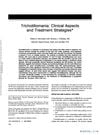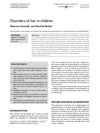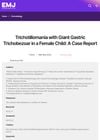TLDR Chronic hair pulling in African American women may be linked to coping and self-satisfaction.
This study explored the relationship between eroticism and chronic hair pulling behavior among African American women, using a narrative-based approach. It involved detailed interviews with 3 self-identifying African American women, aged 18-35, from metro-Atlanta, who have engaged in chronic hair pulling as a coping mechanism. The research aimed to understand this behavior in the context of self-inflicted actions and satisfaction, highlighting a gap in existing discussions on African American hair loss. A non-probability sampling method was used due to the study's specialized nature.
 27 citations
,
March 1994 in “Harvard Review of Psychiatry”
27 citations
,
March 1994 in “Harvard Review of Psychiatry” Behavior therapy and medications, especially clomipramine, can help reduce hair pulling in people with trichotillomania.
 22 citations
,
May 2011 in “American Journal of Clinical Dermatology”
22 citations
,
May 2011 in “American Journal of Clinical Dermatology” Recognizing and managing skin-related psychiatric disorders in children is crucial for effective treatment.
 September 2003 in “Current Paediatrics”
September 2003 in “Current Paediatrics” The document concludes that accurate diagnosis and understanding the type of hair disorder are crucial for treating hair loss in children.
 May 2022 in “European medical journal”
May 2022 in “European medical journal” An 11-year-old girl with a hair-pulling disorder had a hairball in her stomach and was treated with medication, therapy, and a team of doctors.
 13 citations
,
February 2015 in “Actas Dermo-Sifiliográficas”
13 citations
,
February 2015 in “Actas Dermo-Sifiliográficas” The document concludes that recognizing specific histological features of different nonscarring alopecias is crucial for accurate diagnosis and understanding hair loss progression.




